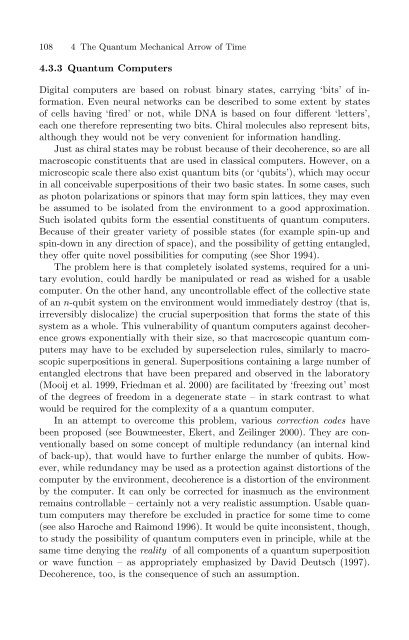The Physical Basis of The Direction of Time (The Frontiers ...
The Physical Basis of The Direction of Time (The Frontiers ...
The Physical Basis of The Direction of Time (The Frontiers ...
Create successful ePaper yourself
Turn your PDF publications into a flip-book with our unique Google optimized e-Paper software.
108 4 <strong>The</strong> Quantum Mechanical Arrow <strong>of</strong> <strong>Time</strong><br />
4.3.3 Quantum Computers<br />
Digital computers are based on robust binary states, carrying ‘bits’ <strong>of</strong> information.<br />
Even neural networks can be described to some extent by states<br />
<strong>of</strong> cells having ‘fired’ or not, while DNA is based on four different ‘letters’,<br />
each one therefore representing two bits. Chiral molecules also represent bits,<br />
although they would not be very convenient for information handling.<br />
Just as chiral states may be robust because <strong>of</strong> their decoherence, so are all<br />
macroscopic constituents that are used in classical computers. However, on a<br />
microscopic scale there also exist quantum bits (or ‘qubits’), which may occur<br />
in all conceivable superpositions <strong>of</strong> their two basic states. In some cases, such<br />
as photon polarizations or spinors that may form spin lattices, they may even<br />
be assumed to be isolated from the environment to a good approximation.<br />
Such isolated qubits form the essential constituents <strong>of</strong> quantum computers.<br />
Because <strong>of</strong> their greater variety <strong>of</strong> possible states (for example spin-up and<br />
spin-down in any direction <strong>of</strong> space), and the possibility <strong>of</strong> getting entangled,<br />
they <strong>of</strong>fer quite novel possibilities for computing (see Shor 1994).<br />
<strong>The</strong> problem here is that completely isolated systems, required for a unitary<br />
evolution, could hardly be manipulated or read as wished for a usable<br />
computer. On the other hand, any uncontrollable effect <strong>of</strong> the collective state<br />
<strong>of</strong> an n-qubit system on the environment would immediately destroy (that is,<br />
irreversibly dislocalize) the crucial superposition that forms the state <strong>of</strong> this<br />
system as a whole. This vulnerability <strong>of</strong> quantum computers against decoherence<br />
grows exponentially with their size, so that macroscopic quantum computers<br />
may have to be excluded by superselection rules, similarly to macroscopic<br />
superpositions in general. Superpositions containing a large number <strong>of</strong><br />
entangled electrons that have been prepared and observed in the laboratory<br />
(Mooij et al. 1999, Friedman et al. 2000) are facilitated by ‘freezing out’ most<br />
<strong>of</strong> the degrees <strong>of</strong> freedom in a degenerate state – in stark contrast to what<br />
would be required for the complexity <strong>of</strong> a a quantum computer.<br />
In an attempt to overcome this problem, various correction codes have<br />
been proposed (see Bouwmeester, Ekert, and Zeilinger 2000). <strong>The</strong>y are conventionally<br />
based on some concept <strong>of</strong> multiple redundancy (an internal kind<br />
<strong>of</strong> back-up), that would have to further enlarge the number <strong>of</strong> qubits. However,<br />
while redundancy may be used as a protection against distortions <strong>of</strong> the<br />
computer by the environment, decoherence is a distortion <strong>of</strong> the environment<br />
by the computer. It can only be corrected for inasmuch as the environment<br />
remains controllable – certainly not a very realistic assumption. Usable quantum<br />
computers may therefore be excluded in practice for some time to come<br />
(see also Haroche and Raimond 1996). It would be quite inconsistent, though,<br />
to study the possibility <strong>of</strong> quantum computers even in principle, while at the<br />
same time denying the reality <strong>of</strong> all components <strong>of</strong> a quantum superposition<br />
or wave function – as appropriately emphasized by David Deutsch (1997).<br />
Decoherence, too, is the consequence <strong>of</strong> such an assumption.



![arXiv:1001.0993v1 [hep-ph] 6 Jan 2010](https://img.yumpu.com/51282177/1/190x245/arxiv10010993v1-hep-ph-6-jan-2010.jpg?quality=85)


![arXiv:1008.3907v2 [astro-ph.CO] 1 Nov 2011](https://img.yumpu.com/48909562/1/190x245/arxiv10083907v2-astro-phco-1-nov-2011.jpg?quality=85)








![arXiv:1002.4928v1 [gr-qc] 26 Feb 2010](https://img.yumpu.com/41209516/1/190x245/arxiv10024928v1-gr-qc-26-feb-2010.jpg?quality=85)
![arXiv:1206.2653v1 [astro-ph.CO] 12 Jun 2012](https://img.yumpu.com/39510078/1/190x245/arxiv12062653v1-astro-phco-12-jun-2012.jpg?quality=85)
